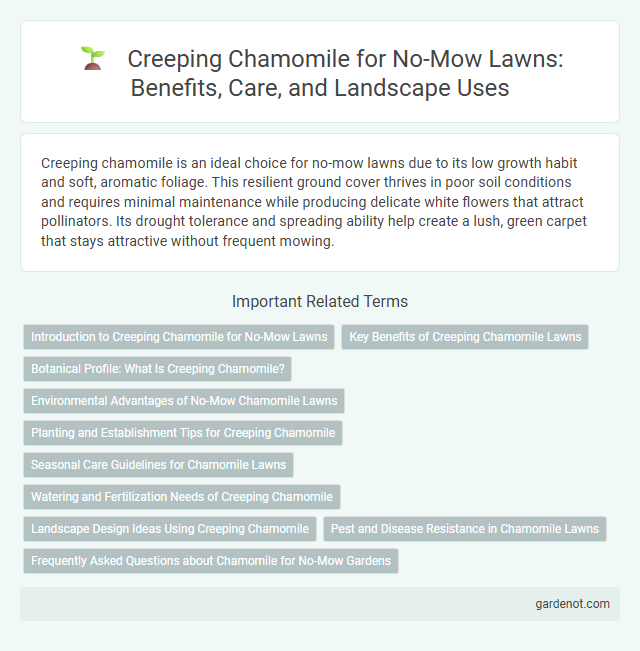Creeping chamomile is an ideal choice for no-mow lawns due to its low growth habit and soft, aromatic foliage. This resilient ground cover thrives in poor soil conditions and requires minimal maintenance while producing delicate white flowers that attract pollinators. Its drought tolerance and spreading ability help create a lush, green carpet that stays attractive without frequent mowing.
Introduction to Creeping Chamomile for No-Mow Lawns
Creeping chamomile (Chamaemelum nobile) is an excellent choice for no-mow lawns due to its low-growing, mat-forming habit that requires minimal maintenance. This hardy ground cover thrives in full sun to partial shade and produces fragrant, daisy-like white flowers that attract pollinators while suppressing weeds. Its drought tolerance and ability to withstand light foot traffic make creeping chamomile an ideal, eco-friendly alternative to traditional turfgrass in sustainable landscaping.
Key Benefits of Creeping Chamomile Lawns
Creeping chamomile lawns offer a low-maintenance alternative to traditional grass, thriving in poor soil while requiring minimal watering. Its natural drought tolerance and ability to suppress weeds reduce the need for herbicides and frequent mowing. The aromatic foliage releases a pleasant scent when walked upon, enhancing outdoor spaces with both beauty and functionality.
Botanical Profile: What Is Creeping Chamomile?
Creeping chamomile (Chamaemelum nobile) is a low-growing, evergreen perennial known for its dense mat-forming habit and fragrant, small, daisy-like white flowers with yellow centers. This botanical profile highlights its adaptability to no-mow lawn settings, thriving in well-drained soils with full sun to partial shade while requiring minimal maintenance. Its botanical characteristics make creeping chamomile an ideal ground cover, enhancing lawn aesthetics and biodiversity without the need for regular mowing.
Environmental Advantages of No-Mow Chamomile Lawns
Creeping chamomile lawns thrive without frequent mowing, significantly reducing fossil fuel consumption and greenhouse gas emissions associated with lawn maintenance equipment. This resilient groundcover supports biodiversity by providing habitat and nectar for pollinators such as bees and butterflies, enhancing urban ecosystems. Its drought tolerance minimizes water use, conserving valuable freshwater resources in residential landscaping.
Planting and Establishment Tips for Creeping Chamomile
Creeping chamomile thrives when planted in well-drained, sandy soil with full sun exposure, ensuring rapid establishment and vibrant growth. Space seeds or plugs about 8 to 12 inches apart to allow for natural spreading and ground coverage, while maintaining adequate airflow to prevent fungal diseases. Consistent moisture during the first few weeks supports root development, after which the plant becomes drought tolerant and ideal for no-mow lawn alternatives.
Seasonal Care Guidelines for Chamomile Lawns
Creeping chamomile lawns require light watering during dry spells to maintain soil moisture without waterlogging. Regular mowing to a height of 1-2 inches in early spring encourages dense growth and enhances weed resistance. Applying a balanced, slow-release fertilizer in spring supports healthy foliage and vibrant blooms throughout the growing season.
Watering and Fertilization Needs of Creeping Chamomile
Creeping chamomile requires moderate watering, thriving best when the soil is kept consistently moist but not waterlogged, making it suitable for drought-tolerant no-mow lawns. Fertilization needs are minimal, with occasional application of a balanced, slow-release fertilizer promoting healthy growth and vibrant blooms without excessive maintenance. Over-fertilizing can lead to leggy growth and reduced ground cover density, so careful nutrient management is essential for optimal performance.
Landscape Design Ideas Using Creeping Chamomile
Creeping chamomile offers a low-maintenance, no-mow lawn option with its dense, aromatic green carpet and delicate white blooms, perfect for eco-friendly landscape designs. Ideal for pathways, rock gardens, and between stepping stones, it provides natural ground coverage while enriching soil health and attracting beneficial pollinators like bees and butterflies. This drought-tolerant plant thrives in full sun and well-drained soils, making it a resilient choice for sustainable landscape aesthetics.
Pest and Disease Resistance in Chamomile Lawns
Creeping chamomile exhibits strong pest and disease resistance, making it ideal for low-maintenance, no-mow lawns that reduce chemical use. Its natural antifungal properties help prevent common lawn issues like powdery mildew and root rot, ensuring a healthy ground cover. This resilience contributes to sustainable landscaping by minimizing the need for pesticides and fungicides in chamomile lawns.
Frequently Asked Questions about Chamomile for No-Mow Gardens
Creeping chamomile (Chamaemelum nobile) is a popular choice for no-mow gardens due to its low-growing habit and fragrant, daisy-like flowers. It thrives in well-drained soil and full sun, requiring minimal maintenance while providing ground cover that suppresses weeds. Gardeners often ask about its drought tolerance, compatibility with other no-mow plants, and how to prevent it from spreading aggressively in limited spaces.
Creeping chamomile Infographic

 gardenot.com
gardenot.com